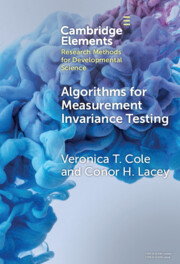Identifying and Minimizing Measurement Invariance among Intersectional Groups
This Element demonstrates how and why the alignment method can advance measurement fairness in developmental science. It explains its application to multi-category items in an accessible way, offering sample code and demonstrating an R package that facilitates interpretation of such items' multiple thresholds. It features the implications for group mean differences when differences in the thresholds between categories are ignored because items are treated as continuous, using an example of intersectional groups defined by assigned sex and race/ethnicity. It demonstrates the interpretation of item-level partial non-invariance results and their implications for group-level differences and encourages substantive theorizing regarding measurement fairness.
Product details
July 2023Paperback
9781009357746
75 pages
230 × 154 × 7 mm
0.127kg
Available
Table of Contents
- 1. Introduction
- 2. Formal Presentation of Psychometric Models
- 3. Empirical Example
- 4. Discussion.




